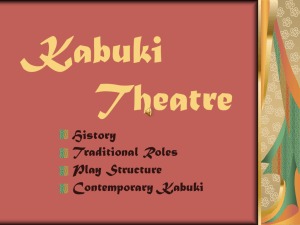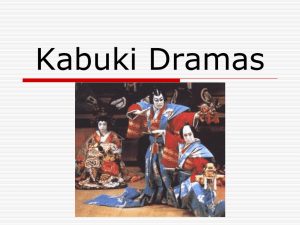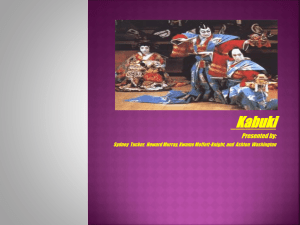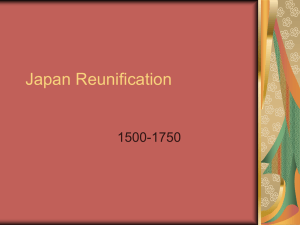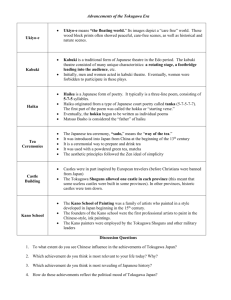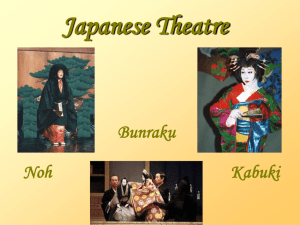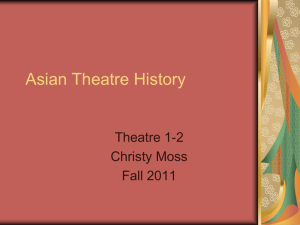Document 10974470
advertisement
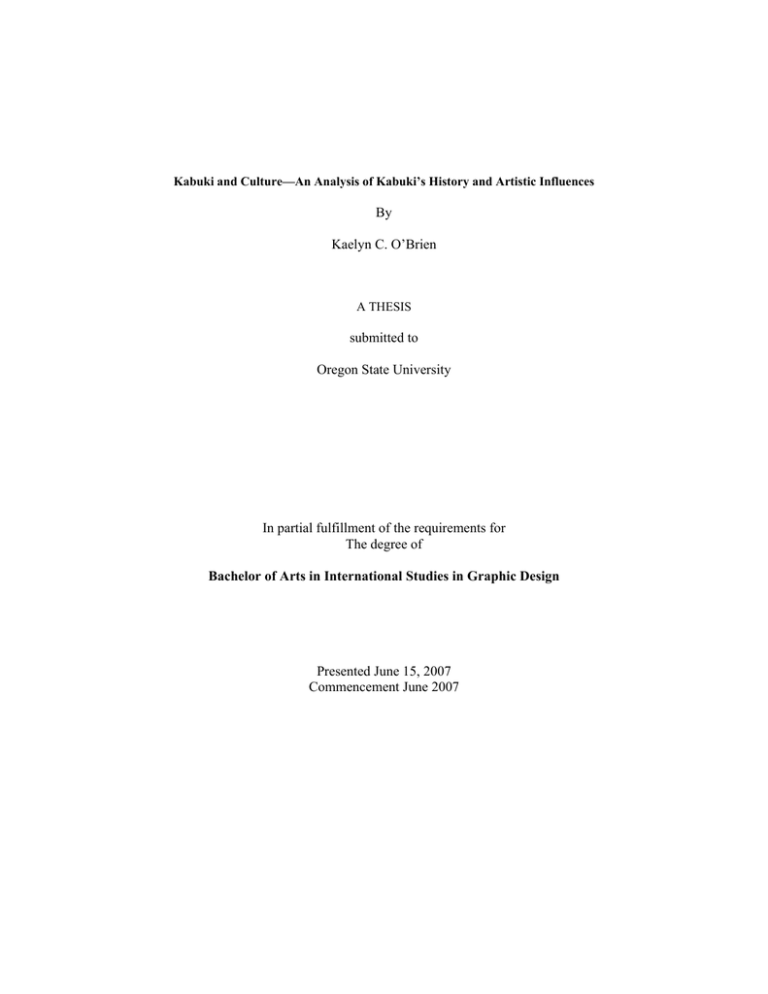
Kabuki and Culture—An Analysis of Kabuki’s History and Artistic Influences By Kaelyn C. O’Brien A THESIS submitted to Oregon State University In partial fulfillment of the requirements for The degree of Bachelor of Arts in International Studies in Graphic Design Presented June 15, 2007 Commencement June 2007 AN ABSTRACT OF THE THESIS OF Kaelyn C. O’Brien for the degree of Bachelors of Arts in International Studies in Graphic Design presented on June 15, 2007. Title: Kabuki and Culture—An Analysis of Kabuki in Japanese Culture and Its Influences Abroad. Abstract Approved: Kabuki theatre, popular entertainment in Edo Period Japan, is a colorful and lively genre that has thrived in the island nation for the past four centuries. Influenced by Japan’s other theatre arts—noh, kyogen, and bunraku—kabuki grew up from simple (if not sordid) origins, and worked for decades to create for itself a memorable style that would keep the townsfolk returning to its theatres. Facing governmental restrictions due to their social status under the Tokugawa shogunate, the actors of the time worked inside and outside the law to give their audiences what was in demand. The popularity of this art, despite the government’s disapproval, was picked up by artists of the era who contributed to the commercialization growing within Japanese cities at the time. Kabuki developed uniquely Japanese aesthetics and conventions, but the art traveled abroad in the years since Commodore Perry forcibly reopened the nation’s harbors to international trade. My intention in this thesis was to research the ways in which kabuki has affected art traditions both inside and outside of Japan. To carry out the study, I have taken a class from a kabuki specialist and read journals and online sources about the history of kabuki—what arts influenced it, how it grew in popularity, how its conventions spread, and how it has been received abroad. In the postmodern art world, where any style from any time period is used, it’s important to look back at traditions and understand from whence our influences came. Bachelor of Arts in International Studies in Graphic Design Thesis of Kaelyn C. O’Brien Presented on June 15, 2007 Approved: Yuji Hiratsuka, Thesis Advisor, Liberal Arts John Maul, Chair of Art Deptartment Dr. Joseph Hoff, Academic Coordinator, International Degree Program I understand that my thesis will become part of the collection of Oregon State University. My signature below authorizes release of my thesis to any reader upon request. I also affirm that the work represented in this thesis is my own work. Kaelyn C. O’Brien, Author CONTENTS Research Methods 1 Tokugawa’s Stratified Society 3 The Ukiyo 5 Kabuki’s Beginnings 6 Noh and Bunraku 8 The Theatre of Pop Culture 10 Setting the Stage 12 Ukiyo-e 15 Japonisme 19 Modern Kabuki 21 Conclusions 22 Bibliography 26 1 RESEARCH METHODS In the spring of 2006, I had the good fortune of attending Waseda University in Tokyo. I’d arrived in Japan with no experience traveling abroad, and found myself largely illiterate and unable to communicate clearly in Japanese. Uneasy in this new position, I enrolled in classes for that term that would be familiar ground: art and culture courses. I found this comfort particularly in a class on the history and conventions of kabuki theatre. While being an art major back home, I’d never gotten a chance to study theatre other than Shakespeare, so learning about a particularly Japanese art form seemed a good choice. I wasn’t let down by this assumption. The professor in for the class, Larry Kominz, had written several books on kabuki and dearly loved the art. Coincidently, he was also an Oregonian who usually taught at Portland State University. Even across the Pacific Ocean, I could find relics of home. Comfort aside, the class was a wonderful chance to learn about the arts of Japan—painting, prints, theatre, music, poetry, and so on. Professor Kominz wanted us to understand how interrelated the artistic media had been to make kabuki what it is. The class culminated in a trip to the Kabuki-za theatre in Tokyo to experience the plays first-hand. From my seat high above the stage, I enjoyed the performance with the aid of an earphone guide (which translated the plot into English). The student to my right fell asleep; the one to my left went to the restroom and never came back, but despite others’ apparent lack of interest, I was fascinated by the presentation. The style was so exaggerated, yet it all made sense within its own traditional logic. At the time, I’d had no idea what my thesis would be for the international degree, so I did little study in Japan beyond what the kabuki class required—reading the text 2 book, reading and watching plays, writing papers to compare and contrast works. My final project for the class was on ukiyo-e prints, for which I studied collections at a few Tokyo museums and then made my own “prints” to copy the styles I’d observed. When I returned home, though, and gave the topic more thought, kabuki seemed the obvious choice for further research. I still had my notes and text book, I had adored the class, and I knew that when I returned to Japan, I couldn’t leave without seeing more plays. Since kabuki is as much about plot as it is about particular details of performance, the more you know of its conventions, the more there is to enjoy. My particular vein of interest, being an art history minor, was the transmission of elements from one medium to others. For instance, many aspects of kabuki seemed familiar to me despite the fact I’d never seen any performances before taking Prof. Kominz’s class. I realized that nuances of kabuki’s performance techniques had been integrated into Japanese work sold in the United States (i.e. anime, video games, and manga). I had already learned in class that other arts had influenced and been influenced by kabuki, so I set about researching in hopes of finding where these artistic connections led. To carry out the research, I looked through what sources were available through Oregon State University. I read books about kabuki’s history and plays, pulled from my kabuki class notes, drew on cultural knowledge I’d learned in language courses and from native Japanese, and looked to my art history texts. What follows, then, is what I found in my research about kabuki’s past and conventions—how it arose, developed, and adapted itself century by century. The story goes like this: 3 TOKUGAWA’S STRATIFIED SOCIETY In 1603 on the dry riverbed of Kyoto’s Kamo River, Izumo no Okuni, a dancer from the Shinto shrine of Izumo, set in motion a trend that would give birth to Japan’s most spirited form of stage acting. Drawing from her experience at the shrine, she put together a band of performers who presented dances and short skits for the entertainment of the citizenry of the imperial capital, and from this simple beginning a new genre of theatre would begin, shaping in its course the artistic traditions of Japan before spreading into Western art circles. The young woman’s skits came to be known popularly as kabuki, which has developed over time into a rich tradition with many particular stylistic elements. It has drawn from other art forms and, as theatre always does, from the culture around it to develop an expansive, yet highly structured, repertoire of plays. However, to understand kabuki’s development and influence, which is felt even into the present, one must first look at the society of Edo Period Japan from which the art form was born. Not long after Okuni began to play her skits in Kyoto, the Tokugawa shogunate gave kabuki its chance to develop without the influence of foreign theatre conventions. The Edo Period of Japanese history was a time of isolation. Tokugawa Ieyasu, the progenitor of the line of shoguns, unified Japan’s bickering territories into a single nation. Nearly two decades after his death, the shogunate banned foreigners from entering Japan (1630), stopped Japanese natives from leaving the country (1635), and finally closed all ports to foreign ships save for Nagasaki, where the import of foreign goods and ideas was strictly regulated (1639).1 1 Tsuneko S. Sadao and Stephanie Wada, Discovering the Arts of Japan: A Historical Overview (New York: Kodansha International, 2003), 200 4 The Tokugawa shogunate enforced a stratified society that consisted of six levels (though only the middle four are usually discussed). The top level was the imperial court, stripped of power yet still a symbolic source of national unity. The samurai class, including the shogun’s government, was the nobility—they held jobs as bureaucrats and peacekeepers. The next three levels were the chonin (townsfolk). The farmers ranked highest, followed by artisans, and finally merchants. Though generally wealthiest of the classes, merchants were looked down upon because their jobs as traders weren’t valued as highly as those who created useful goods. 2 The non-people were those who fit into none of these categories, though not all were looked down upon. Fitting into this social caste were the actors and prostitutes of the time. They provided entertainment (sometimes overlapping), but did nothing that the government considered productive. While the shogunate didn’t recognize them within the system and sometimes even took action against them as catalysts of unrest, these people kept (literally) at the edge of society came to be idolized by those of “higher” standing. The common man felt the burden of the government constantly via heavy censorship, sumptuary laws, taxation, and restriction of travel.3 A system of alternate attendance, under which samurai nobles had to spend half the year in Edo, leaving behind their wives, children, and much of their households, kept the lesser lords spending money on travel, alternative lodging, and lobbying the shogun’s officials.4 With so much money 2 Sandy Kita, “From Shadow to Substance,” in The Floating World of Ukiyo-E (Harry N Abrams, Inc. in Association with The Library of Congress, 2001), 28-29. 3 Kita, “From Shadow to Substance,” 29-30. 4 Sado and Wada, Discovering the Arts of Japan, 200. 5 tied up under the enforced system, an organized revolt against the shogun would have been difficult to fund. 5 THE UKIYO Under these social conditions, the Ukiyo District was born in Edo (now Tokyo), the center of the shogunate’s power. The art historian Janet Wolff argues in her writing that innovation doesn’t occur within a vacuum devoid of societal demand; new techniques or technologies are always put forward to fill a need which already exists, even if it wasn’t the initial intention of the innovator.6 The Ukiyo, and the art depicting it that followed, filled such a void in Edo society. A city teeming with bored and oppressed men needed something to distract them lest revolt ensue. The townsfolk, particularly the wealthy merchants, had extra money, but the sumptuary laws restricted what they would buy. The shogunate, therefore, established a pleasure district on the outskirts of the city. This floating world was home to the theatres and the brothels, and within this section of the city, class mattered less than money. If you could pay for it, you could have it. The shogunate, while still asserting that the laws of the social system applied everywhere, was willing for the most part to turn a blind eye in order to avoid the wrath of the populace.7 Ukiyo, translated as either floating world or sorrowful world, draws upon the Buddhist principle that life is fleeting. Over time this notion of ephemeral existence came to be reinterpreted from a somber concept into one that encouraged living a happy, impulsive (if sometimes shortened) life.8 A common merchant could indulge like a lord, 5 Sado and Wada, Discovering the Arts of Japan, 200. Janet Wolff, “The Social Production of Art,” 26-28, The Social Production of Art, Second Edition (New York: New York University Press, 1993), 38. 7 Kita, “From Shadow to Substance,” 29. 8 Allen Hockley, Inside the Floating World (Washington: University of Washington Press, 2002), 24-25. 6 6 and a samurai9 could play the part of a common man. The joys and liberation of the pleasure districts were gone by morning, but were grand while they lasted. We can see this concept clearly illustrated in a print by Suzuki Harunobu from around 1768. The Letter10 gives a rare glimpse into the deceit intrinsic to the pleasure quarter, where only money mattered. Most depictions were meant to glorify the courtesans (since the works were often commissioned by brothels), and while the woman in this print is indeed beautiful, the subject matter is less endearing. The woman lies beside a brazier where she is making tea for her customer. An attendant has come in and covered the eyes of the man, who lies comfortably on the floor with no signs of distress; he likely thinks it’s the game of a flirtatious girl. However, the attendant holds in her mouth a love letter written by one of the courtesan’s other customers. Courtesans could carry on long relationships with various men, but often when the money was gone, so was the affection. The appeal of love was dangerous—at the time many marriages were financial and utilitarian. The lavish attention given by the courtesans ruined many rich and unwary men.11 KABUKI’S BEGINNINGS As mentioned earlier, Okuni had set up her stage on the dry riverbed of the Kamo, a place that belonged to no one and was open to the use of entertainers. Her original works bore only some resemblance to current kabuki. The first performances her troupe presented were relatively simple and required little plot. Usually the program would 9 Being banned from the district (because the shogunate allowed but frowned upon the place) didn’t stop the nobles in the least. 10 See Figure 1. 11 Hockley, Inside the Floating World, 25-27. 7 begin with a song and dance section. Following this would be a skit where a man (usually Okuni herself dressed as a dandy) goes to a brothel to pick up a prostitute. The final skit would be a scene at the public bath where female attendants attracted the attention of other bathers. 12 Simple as these skits were, they proved to be very popular. With the success of Okuni’s troupe in Kyoto, other groups began to stage similar performances to attract patrons for the women’s services. Patrons paid to see the shows to preview the women on stage and select a partner for the evening and weren’t concerned as much with the quality of the acting or plot.13 No evidence shows that Okuni and her troupe engaged in this prostitution despite the innuendo inherent in the performances, but this era of women’s kabuki came to be known as “prostitute’s kabuki.”14 While the government looked down upon such performances and their actors, no action was taken to stop the situation until quarrels between samurai patrons for certain prostitutes began to draw interest. 15 Acting to maintain social peace, the shogunate came forward in 1629 and banned women from performing on public stages. Much as had happened in Europe, young boys were brought in to fill the female roles in the skits. However, the ban didn’t have the desired effect; the prostitution inherent in the entertainment didn’t stop, but now patrons could buy the affections of a boy rather than a woman. At the time, Japanese society didn’t object to homosexual relationships, and in some texts the love of a man for another man was praised above love for a woman. 16 12 John Wesley Harris, The Traditional Theatre of Japan (Wales: Edwin Mellen Press, Ltd., 2006), 163-164. Harris, The Traditional Theatre of Japan, 164. 14 Laurence R. Kominz, The Stars Who Created Kabuki (New York: Kodansha International., 1997), 19. 15 Harris, The Traditional Theatre of Japan, 164. 16 Kominz, The Stars Who Created Kabuki, 20. 13 8 Despite the social acceptance of the patron/catamite relationship, the change to all-male kabuki didn’t stem the violence that the government had been trying to suppress. Unable to impose control in the decades following the female ban, the shogunate finally put an end to boy’s kabuki in 1652, though it took several years after the edict to snuff the practice entirely. It wasn’t that boys were removed from the stages as women had been, but instead they were forced to change their appearances to make them less eroticized. While stage managers still managed to get around the changes and bribe officials into ignoring the continued prostitution, the mood of the productions was changing. 17 NOH AND BUNRAKU With repeated interference from the government trying to stamp out the prostitution and resulting violence in the theatres, actors began to look to other stage traditions for a solution. Japan’s historical theatrical art of noh was (and is) a slow, dramatic, and serious sort of drama, which often depicted tales from the nation’s folklore. The slow, rigid movements and one-expression-fits-all masks worn by actors were a far cry from kabuki’s lively, athletic performances, but early in the 1600s the shogunate had disbanded many noh and kyogen (a livelier acting style performed between noh presentations) troupes. Many displaced actors from these genres joined kabuki troupes. 18 Having begun contemporaneously to kabuki, modern bunraku (known at the time as joruri) was a major competitor. In bunraku, puppeteers control elaborate dolls who act out the gestures of plays as they are recited by a narrator. The doll operators prided 17 18 Kominz, The Stars Who Created Kabuki, 21. Kominz, The Stars Who Created Kabuki, 20. 9 themselves in making the puppets mimic human emotions and actions accurately, a skill that only became more elaborate over the decades. However, often the narrator and his reputation for artful recitals was what drew audiences.19 Whatever the case, the plots of bunraku were far more developed than those of kabuki, and a great range of special effects were possible with the dolls that a live actor would have trouble with (such as being beheaded or jumping over a castle wall).20 With both the influx of actors from noh and the cross-germination with bunraku, the plots for kabuki plays began to grow more important and elaborate. Plays written for the puppets, like the massively popular Chushingura21, were adapted into kabuki. Traditional noh and kyogen plays were reworked to be livelier.22 This all certainly doesn’t mean that kabuki did nothing but borrow, though. Playwrights were employed to write new stories for each season, and while some themes were particularly popular and the same titles are performed often through the years, each iteration would be written or adlibbed differently to keep audiences returning.23 It was this spontaneity that came to characterize kabuki. Noh and bunraku both adhered strictly to the scripts as they were handed down. Bunraku puppeteers couldn’t adlib parts of the performance any more than the narrator could or it would throw off the unity of the performers. Noh techniques were passed down from one generation to the next with apprentices instructed in the exact ways to move and speak to perform the piece rightly. To keep the works in time with the music and other performers, precision was 19 Harris, The Traditional Theatre of Japan, 146. Harris, The Traditional Theatre of Japan, 151. 21 Chushingura is a classic Japanese revenge story in which the lord of a household is goaded by a jealous government official into attacking. The lord is ordered to commit seppuku (traditional suicide), so his retainers band together to avenge his death upon the unpunished official. 22 Harris, The Traditional Theatre of Japan, 173. 23 Harris, The Traditional Theatre of Japan, 193-194. 20 10 vital.24 Kabuki, however, came to be an art form open to the manipulation of the actors and audiences. THE THEATRE OF POP CULTURE Unlike noh and bunraku, kabuki was an informal production. People talked before and after the plays. Food was sold in the theatres, and the audience would eat throughout the entertainment. If an actor played a part well, viewers could call out praise and cheer during the performance. The closeness between actor and audience was particularly evident on the hanamichi, a long walkway that passes through the audience’s seats. Many actors enter and exit via this path, which brings them right into the ranks of their patrons.25 As the form developed and gained respect, actors could step out of character and address the audience without objection.26 Each actor could adlib lines to add variety and emphasize his own talents. Playwrights for kabuki troupes were usually required to write plays that showcased the specialties of each actor within the group. If there was no place in a production for someone, a part was written.27 Due to this approach to writing, many plots became convoluted or nonsensical, but this didn’t deter the audiences. Much of the performance was about virtuoso actors showing what they could do, and even if the characters weren’t believable in many cases, the audiences were coming to see their favorite actors and the new fashions of the Ukiyo.28 24 Harris, The Traditional Theatre of Japan, 146. Harris, The Traditional Theatre of Japan, 159-160. 26 For instance, if an apprentice to a popular actor was appearing on stage for the first time, his mentor could stop the scene to give a formal introduction. 27 Harris, The Traditional Theatre of Japan, 193. 28 Harris, The Traditional Theatre of Japan, 181-182. 25 11 Kabuki and the Yoshiwara (the brothels) were always on the cutting edge of every trend. They required for their performances and trysts the newest music, clothes, hairstyles, and products.29 Women impersonators in Kabuki, onnagata, set trends for women’s fashion and even sold their names to endorse products—if such things could make a man into a delicate lady, it would work wonders for real women. Kabuki drew from the style of the courtesans, the courtesans from kabuki, and they all drew from the vogue of the imperial court and other cities. The whole district was festivalized. Every night was a party and each season had its special entertainments.30 Kabuki often reflected the lives of the patrons of the Floating World. Three types of plays were particularly popular: historical plays, domestic plays, and news plays. Historical plays were based around the folkloric legends and embellished events in Japan’s past. Domestic plays were often about love affairs with some complication to them—possibly differences in social rank or hopeless love between a patron and a courtesan. The domestic plays glorified the Ukiyo district and its joys and downfalls.31 The news plays drew a lot of attention from the public and the government. Seeking to capitalize on the public’s interest in recent events, playwrights could have a production ready within a few days of the happening. These over-dramatized versions of contemporary’s lives often focused on rumors within the Ukiyo district, problems in high samurai houses, and sensationalized murders. While the plays rarely presented the true motivations behind such matters, exaggerating and inventing plots were never seen as inappropriate.32 29 Hockley, Inside the Floating World, 21-22. Larry Kominz, “The Splendor of Kabuki,” Lectures at Waseda University, 18 April- 8 July 2006. 31 Harris, The Traditional Theatre of Japan, 171-172. 32 Harris, The Traditional Theatre of Japan, 166-168. 30 12 Due to the popularity of the art form, the government looked upon it with suspicion. The stage was a dangerous ground where criticism of the shogunate might sew the seeds of disorder. Despite the government’s watchful eyes, the kabuki players wouldn’t be put off from presenting contemporary subjects. To avoid censorship, they’d often write stories set in earlier centuries but the plots would be thinly-disguised versions of present-day scandals.33 One particularly popular subject that earned the wrath of the government was the sensationalizing of love suicide stories. As the story goes, in 1703 the popular playwright Chikamatsu Monzaemon heard about the recent suicide of a courtesan and her lover, but no one knew the reasons behind the tragedy. Chikamatsu wrote The Love Suicides of Sonzeaki for the bunraku theatre, giving his spin on the story. While earlier suicide stories had been presented, this one was of such superior quality it was an unquestioned success and was later adapted to kabuki. The genre enjoyed great successes, but with the glorification of such suicides, some audience members began to enact what they saw on stage. With increasing suicide rates, the shogunate again stepped in and banned such plays in 1722.34 SETTING THE STAGE By the mid-eighteenth century when kabuki was well established within the major cities, troupes had set up a system by which they formed anew each year. At the beginning of the year’s run, actors and playwrights would be contracted to certain theatres and apprentices would be assigned. Theatres kept up traditions of playing certain 33 34 Harris, The Traditional Theatre of Japan, 170. Harris, The Traditional Theatre of Japan, 168-169. 13 sorts of shows at each festival on the calendar, calling for their writers to rework the themes anew each year but keeping them similar enough to give the audience what was expected. With the continual turnover of talent in the theatres, this set program of plays through the year gave continuity to an otherwise hectic art form.35 The year began in late summer when the troupe was signed on at a theatre. The first performances of the kaomise, “face showing”, occurred in the 11th and 12th months of the year. These productions familiarized the audience with the troupe’s set up and showed off the best talents of each member. During this first part of the year’s performances it was expected that a Shibaraku performance would be included somewhere. This sort of play was always roughly the same. Two innocents have been taken hostage by an evil man. Just as they are about to be killed, someone offstage yells for them to stop. The hero comes out, gives a speech, and beheads several men with one swing of his sword, thus saving the endangered people. The entry speeches are often different year to year, the reasons the people have been kidnapped varies, the motives for the villain change, but the plot is expected to remain constant. 36 The rest of the year had other traditional plays woven into the history of the theatre, but most works were written as composites of other works, events in history, folklore, and whatever the actors wanted to include to show off their skills. At the beginning of kabuki’s history productions started at dawn and ended at dusk, allowing writers to set up long, complex plots.37 In today’s kabuki, shows are usually three to five hours long and only present the most popular acts of the longer plays. Since each act 35 Harris, The Traditional Theatre of Japan, 196-197. Harris, The Traditional Theatre of Japan, 172. 37 Harris, The Traditional Theatre of Japan, 197-198. 36 14 might be written by a different author, they were often self-contained plots and are well suited to this treatment. As may be evident from everything written hitherto, the point of kabuki isn’t the accurate representation of life or history. Exaggerated makeup, costumes, hairstyles, and other fashions are only the surface level of the farce. Onnagata often work at their roles all through their lives, so a middle-aged man may act as a young and beautiful courtesan. Historical figures popular to the tales of Japan are often juxtaposed with others from different time periods, presenting a compression of time where two unlikely characters are forced to interact with each other in a drawn out hypothetical scenario.38 Indeed, transformations are a mainstay of the kabuki tradition—many plays focus on veiled identities. A character will be known as one person through half the play, and near the end may reveal himself to be truly a figure who’d lived centuries in the past. Some people eventually show their true nature to be that of a fox or some other animal. A popular play that focuses on false identities is Sukeroku, one of many plays that centers around the celebrated Soga brothers and is often integrated into the kabuki program. Sukeroku is the story of a young dandy in the pleasure quarters who is picking fights with anyone carrying a sword. Midway through the play, it’s revealed that the man is actually Soga Goro, younger and fiercer of the Soga brothers who are out to revenge the murder of their father. He’s fighting everyone to try to find his father’s stolen sword, without which he cannot exact his revenge.39 Plots aside, the stage itself also isn’t often set up in a way that suggests real space. As few props as possible are used on kabuki stages, and once they’ve served their 38 39 Larry Kominz, “The Splendor of Kabuki.” Larry Kominz, “The Splendor of Kabuki.” 15 purpose, they are plucked off the stage by an assistant in black, called a kuroko. Positions upstage and downstage are given a strict hierarchy which always gives greatest emphasis to the hero. If something important is going on at a certain point on the stage, time may stop for other characters, freezing them in place, to add emphasis to the action. As tensions rise within a plot, at the climax of scenes actors will freeze for several seconds in dramatic poses in a move that is called a mie (some of which were set up with watching ukiyo-e artists in mind). As a convention, if someone turns his back to the audience, that person is invisible—an actor may turn his back, sit on a stool, and have a cup of tea while he waits for his role to resume if there’s time. As with noh, kabuki’s lines are spoken in a poetic, rhythmic fashion despite using colloquialisms, and puns on words to create duel meanings are common.40 UKIYO-E The makeup, bright colors, stylizing of sets and costumes, dynamic positions, and other conventions of kabuki weren’t lost on the artisans of the era. Capitalizing on the popularity of the theatres and green houses (as the brothels could be called), artisans developed a style of woodblock printing that came to be called Ukiyo-e, “Pictures of the Floating World.” These prints came to be the means by which Western audiences got their first glimpses of kabuki. Ukiyo-e from the 1770s to the 1860s was mostly dominated by four themes41: actors, courtesans, landscape, and warriors.42 Each of these themes has something revealing to say about the character of the Japanese culture at the 40 Harris, The Traditional Theatre of Japan, 183-191. Other subjects were popular at various points in ukiyo-e’s history, such as ghosts, sumo wrestlers, birds, flowers, and erotica (with some overlap with courtesan prints), but the four themes mentioned above were more widely disseminated. 42 Hockley, Inside the Floating World, 39-40. 41 16 time, but we will begin with the two former themes, actor and courtesan, since the demand for them was greatest. The artists of the time were in tune with this popular culture and weren’t going to miss the opportunity to profit from it. When people walked out the gates and their fantasies evaporated, they still wanted to remember the experience. Since the pleasure district had to cater to rich and poor alike and was an ever-changing frenzy of fashion, painting as a medium was too costly and slow to supply the demand for depictions of the courtesans and actors. Often the portraits were idealized43, giving emphasis more to the lavish clothing rather than the individual.44 True to Janet Wolff’s argument that technologies available are key to how artists create, the technical mastery of the Japanese woodblock print was born from this need for fast and mass production.45 A mass of prints could be ready within days of any given event or style. They were cheap to make, so losses from an unpopular series could be easily recouped, while successful prints made considerable profits and could be duplicated to supply demand.46 Men and women who wanted the latest fashions could count on the printmakers to regularly supply references straight from the Ukiyo. By 1770, the influence was so felt that the author Tatsuya Naramoto noted that “…wherever you go, barbershop or bathhouse, whatever people are discussing, whether loyalty, chastity, or filial devotion, every example is kabuki.”47 With a wealth of other literary history to 43 Facial features and body types were, for mostof ukiyo-e’s history, generalized into ideal models. A few details might be emphasized for specific people, but most subjects were rendered the same. The women in Figure 2, for instance, have unique clothes, but they are not meant to look like the models. 44 Hockley, Inside the Floating World, 11. 45 Wolff, “The Social Production of Art,” 25. 46 Hockley, Inside the Floating World, 11-12. 47 Tatsuya Naramoto, Nihon no Rekishi (Tokyo, 1966); quoted in Roger S. Keyes and Keiko Mizushima, The Theatrical World of Osaka Prints (Boston: David R. Godine in Association with Philadelphia Museum of Art, 1973) 40. 17 choose from in Japanese history, it was kabuki the people turned to for examples that they could relate to their lives. Ukiyo-e prints were produced in workshops by the combined efforts of many artists—those who sketched the initial designs, made the transfer images, chiseled the blocks, and printed the images. Publishers often supplied the theme for a series, and shopkeepers had a say in what eventually got sold, but the censors had the final word. The government mistrusted what sort of commentary might be disseminated by the plays and prints of the Floating World, so each design had to be approved before carving could begin. When finished, each print had to have a censor’s seal stamped on it. While this filtering process kept printers from overtly commenting on current issues, they found ways around the strict rules by embedding hidden meanings into many works or by depicting historical situations which could be interpreted through the lens of contemporary events.48 While some artists worked around the censorship, others turned to less controversial topics. Landscape painting developed later in ukiyo-e’s history, but it proved popular. During the Edo Period most travel was strictly controlled by the government. People were expected to remain in the areas they were born, and if they wanted to move to or visit another place, they needed a logical reason and written permission from the government to undergo the trip. The easiest way to get said permission was to undertake a pilgrimage. Famous Shinto shrines and Buddhist temples were huge attractions at the time, and pilgrimage routes along the government-controlled 48 Frank Whitford, Japanese Prints and Western Paints (New York: Macmillan Publishing Co., 1977), 47. 18 roads were populated with inns all along the way. To commemorate these trips, printers depicted the inspection stations, attractions, and religious locations all along the roads.49 The warrior prints reflected back on the rich tradition of Japanese folklore and history, presenting to the Edoites, who’d known relative peace for over a century, a link to their warlike past. The scenes selected often were meant to highlight a feature of the warrior’s personality, such as Katsukawa Shun-ei’s print Yoshitsune Recovering his Bow at Yashima.50 In the picture, Yoshitsune, a handsome and well-armored warrior, sits astride his horse as the animal struggles in the turbulent water. Enemies make thrusts at the warrior with their swords from a boat in the background, but Yoshitsune has turned his back and pays them no heed. Holding his sword high in his right hand, he reaches with his left for a bow floating nearby. This show of confidence and composure in the face of mortal danger is underscored by the reason for his attempts to recover the bow, a story passed down in the famous Tale of the Heike. While other soldiers scolded him for risking his life for a bow, he replied by saying he would not suffer an enemy to fish the bow out and associate such an inferior weapon with Yoshitsune’s proud name.51 Through all of these themes of ukiyo-e we see the reoccurring thread of vicarious life. The people of the period, so rigorously controlled, saw in the depictions that which they desired for themselves. To live a life of fame like an actor, one of pleasure and entertainment like a courtesan, to travel far to places they had once seen or might never see, or to connect back to the glorious past of great warriors—all of these themes provided daydream escapes from mundane realities. The art of ukiyo-e displays a cultural need for escapism, an underlying desire for freedom of action. 49 Hockley, Inside the Floating World, 46-47. See Figure 3. 51 Hockley, Inside the Floating World, 41-43. 50 19 By looking at the subjects of these prints, we see what society obsessed over and desired. Though the medium we see the needs of the people for fast and ephemeral art. While a formal or stylistic analysis would yield a rich view of where ukiyo-e fits in the family tree of Japanese artistic expression, it is when you look at it from a broader view that the art form comes alive. It speaks less of one courtesan, one actor, or a fine technique in line and color; it instead shows the hopes of a culture and a time, speaks of the ephemeral nature of life and pleasure. JAPONISME Naturally, when these prints arrived in Europe after Japan was forced to reopen in 1853, the new Western audience didn’t immediately see the social underpinnings of the prints and the entertainment district that had produced them. Most of the pieces came as packing material to cushion other goods, showing how unvalued and mass produced they were in Japan by that time. The ephemeral nature of the prints encouraged the consumer to pick them up and throw them away when the next new series was out. However, some were bought by travelers to Japan and brought back for show.52 By whatever means the works were transported westwards, their influence was soon felt in the European art world. It was still the colonial era of Europe, and the arts and cultural artifacts of other occupied countries were being sold in Western markets. There had been minor crazes for certain styles—those of India or sections of Africa, for example—but the lust for Japanese works was the most fervent and long-lasting.53 52 53 Whitford, Japanese Prints and Western, 24. Whitford, Japanese Prints and Western, 22-23. 20 The most notable artists to pick up this trend, called japonisme, and apply it to their art were the French Impressionists. The prints held a new style and aesthetic to them that contrasted starkly to the traditional expectations of gallery painting in Europe. The extremely vertical or multi-panel compositions showed a reevaluation of what was important within a composition and how the scene could shift in mood based on how it was laid out. Cropping the figures was seldom done in paintings of the time, but Ukiyo-e had long used the technique. Very high or low viewpoints flattened the views of the prints and brought everything in towards one plane and added dynamism to the works. Perhaps most marked of techniques that the western artists noticed was the use of large blocks of solid color to give focus to certain detailed areas. In European art, the concept of horror vacui, a disdain for undecorated space in a composition, could be noted from even the Middle Ages, but the Japanese prints used these restive areas of the composition to draw the eye back into the more essential areas, much like kabuki did with the freezing of time.54 It wasn’t long before several influential artists were integrating what they’d observed into their own works. Notably Degas, Manet, Monet, and Van Gogh all showed applications of what they were studying in the foreign works. In some cases, direct copies in paint of Japanese prints were executed to study the techniques.55 In addition to changes in composition, many artists integrated imported art objects56—kimonos, fans, prints—into the subject matter of their works.57 While kabuki itself wasn’t performed commonly outside of Japan until recent decades (the first tour in the US was in 1960), its 54 Whitford, Japanese Prints and Western, 107-112. See Figure 4. 56 See Figure 5. 57 Whitford, Japanese Prints and Western, 104-105. 55 21 influence was felt abroad from the time that Japan reopened. Fresh views on composition, dynamism, and color transmitted by ukiyo-e helped to influence the next several generations of Western artists. MODERN KABUKI Kabuki still exists today much as it had during the Tokugawa shogunate, but its plays have been seemingly permanently relegated to past eras. After World War II during the occupation by American forces, many social traditions within Japan came under the scrutiny of the officials stationed there. With its glorification of the stratified society and ingrained traditions of fealty and self-sacrifice (particularly seppuku/harakiri), the American reviewers gave serious consideration to banning kabuki all together as a relic of the militaristic past and a detriment to democracy within the nation. However, Oliver Statler, an American stationed in Japan who’d become a fan of kabuki, and several other international travelers who’d seen performances stood up for the art form and opposed its demise. It was argued that taking away a traditional art form would be as detrimental to the recovering country as deposing the Emperor; such concepts were so ingrained in the culture that action against them would only cause resentment and rebellion. Thanks in part to these outspoken protests, kabuki was preserved, but because much of the argumentation had centered around the assertion that kabuki was a cultural documentation of histories, new plays about current events were no longer produced in mainstream kabuki. While no prohibition stands on the theatre, many kabuki’s producers have continued the tradition of setting plays in the Heian to Edo Periods.58 58 Larry Kominz, “The Splendor of Kabuki.” 22 Some, though, like the actor Ichikawa Ennosuke have begun editing old kabuki plays to more accessible to today’s audiences. These productions have faster paced dialogue and focus more on action and spectacle. While frowned upon by some traditional actors, Ichikawa’s productions have enjoyed success with younger audiences in Japan, and he hopes this “super kabuki” will help keep later generations interested in their artistic heritage. On a similar note, women are no longer technically banned from kabuki, but most theatres have maintained the tradition of keeping all-male casts. In response to this, female troupes have emerged in which all roles are played by women, much like the progenitors of kabuki had done. These female troupes are just as stylized as traditional kabuki, but show Western themed plays as well, including translations of Shakespeare.59 CONCLUSIONS Kabuki has had a long, up-hill history. It had its humble beginnings in a dry river bed, the best place for an upstart troupe that couldn’t pay rent for a proper staging area. It was threatened with restrictions and censorship as it grew in popularity, and its actors were charged repeatedly with disrupting the peace and overstepping their station in life. Through three and a half centuries the art form has had to draw upon other theatres, society’s mishaps and intrigues, and its own old traditions to continually recreate material that will hold the interest of audiences. The spectacle that has fascinated the populace of Japan for generations has proven a drawing force to people of many nations, as countless tourists flock to the kabuki theatres to watch dramas and listen to ear-phone translations. Student productions of 59 Larry Kominz, “The Splendor of Kabuki.” 23 kabuki are being coordinated in the U.S. and other countries now. While still a distinctly Japanese art, kabuki now is spreading its stories abroad. Looking at this long history condensed, I’ve found some of what I was looking for, but not all. The long-established arts of noh and kyogen could be drawn upon by kabuki to give legitimacy and position to an upstart art form within a rigidly structured society. The interchange between these theatre forms and the friendly rivalry between kabuki and bunraku nurtured a setting where many presentation styles could be appreciated because all drew upon traditions and histories held dear in Japan since time immemorial. Music, stories, actors, and techniques were exchanged amongst them. Yet, this interplay also encouraged each art to retain its stylistic fingerprints, as it were. Each wished to portray something that the others couldn’t accomplish, or dramatize the same events with details befitting the acting genre. Noh kept its austere solemnity and supernatural distance. Bunraku had its special effects and praiseworthy imitation of human actions. Kabuki had its dazzle and display; it had a charm that endeared it directly to the audience. Kabuki’s influence is felt throughout the culture because it was pop culture within the major cities. For much of its history, the presentations catered to what was popular (or what kabuki wished to make popular). The stars were venerated throughout society, and innovators within the discipline were copied both by subsequent generations of actors and by the audience. Many kabuki plays’ scripts were sold so fans could play out kabuki scenes to entertain company. Literature in the period began to emulate kabuki’s style, focusing on every-day society and integrating humor.60 With four centuries of popularity, 60 W.G. Beasley, The Japanese Experience (Los Angeles: University of California Press, 1999), 182. 24 conventions of the stage have been adopted by the Japanese populace as elements to use within other media. While I was pleased to find the direct connection of kabuki to French Impressionism (via ukiyo-e), and I do think that such a sharing of style is key to later art movements in the West, I had been hoping to find more references to contemporary transmission. However, with the research I’ve done, I realize now that such a trail would be hard to follow in recent decades, especially with the coming of the internet. In the post-modern art world, aspects of any style from any time period are up for use. As such, the histories of where visual styles truly came from are usually veiled and heavily mixed. Even with this hampering the trail, kabuki had become so entrenched in Japanese pop culture by the 1850s, transmission of almost any aspect of Japanese culture would contain reference to the stage art. I found many arts from which kabuki had drawn, and that had been half my goal. I even found one source that suggested Okuni’s original performances had been inspired by Christian dramas that had been displayed to the public in hopes of drawing converts.61 Despite having been thwarted somewhat on the transmission side of the research, there are a few points I’d like to make about my own observations. While I couldn’t find any credible sources in my half year of hunting that would back up these observations, I think they would be interesting topics for further research when I have more time. While I found the direct link between ukiyo-e and Impressionism, what I’d hoped to find was one between kabuki/ukiyo-e and anime (Japanese animated cartoons) or manga (Japanese comics), which are art forms consumed increasingly in the US and 61 Toshio Kawatake, Kabuki: Baroque Fusion of the Arts (Tokyo: International House of Japan, 2003), 260262. 25 abroad presently. I found on the internet fleeting references of connections between ukiyo-e and the manga/anime style, but no published source I read backed this up. While aspects of coloration, story, and flattened or stylized space could be explored, I was particularly interested in finding borrowings of stage conventions. For instance, in an anime I watched recently called Disgaea, in one episode two characters were suddenly taken out of the context of the story and placed on a kabuki stage where they circle each other and speak in poetic kabuki-style language. In a video game called “Cooking Mama” for the Nintendo Wii, if you complete a recipe very well, the main character appears on the screen with red makeup on and in a mie pose. By means of such allusions, Western audiences are exposed to kabuki’s conventions often without recognizing them for what they are. My study had several limitations. Having only chosen my topic after returning from Japan, I lost my chance to see more kabuki performances and use the resources available at Waseda University. While an ample number of books have been published on the topic, my brief period of study hampered the amount I could read, particularly had I wanted to do further study into anime and manga’s histories. Given more time at a later date, more reading and talking with those involved in the transmission and performance of kabuki would be helpful in expanding this thesis. Perhaps it would be an interesting study as decades pass to look at how kabuki changes over time as it is performed to new audiences who have grown up outside of Japanese society. As media move from country to country and more information gets disseminated about them, new cultures tend to use aspects of the style as best suits their needs (much as the Impressionists used concepts they saw in Ukiyo-e). Kabuki has been 26 adaptive all through its history, but as mentioned at the onset of this essay, it enjoyed for most of its history the privilege of developing without major outside influences; one can only guess at how it will re-create itself to suit the tastes of a new generation and culture of fans as it spreads ever farther across the globe and becomes ingrained in other cultures. BIBLIOGRAPHY Beasley, W.G. The Japanese Experience. Los Angeles: University of California Press, 1999. Harris, John W. The Traditional Theatre of Japan. Wales: Edwin Mellen Press, Ltd., 2006. Hockley, Allen. Inside the Floating World. Washington: University of Washington Press, 2002. Kawatake, Toshio. Kabuki: Baroque Fusion of the Arts. Tokyo: International House of Japan, 2003. Keyes, Roger S., and Keiko Mizushima. The Theatrical World of Osaka Prints. Boston: David R. Godine in Association with Philadelphia Museum of Art, 1973. Kita, Sandy. “From Sahdow to Substance,” In The Floating World of Ukiyo-E, 27-79. Harry N Abrams, Inc. in Association with The Library of Congress, 2001. Kominz, Larry. “The Splendor of Kabuki.” Lectures at Waseda University, 18 April- 8 July 2006. Sadao, Tsuneko S., and Stephanie Wada. Discovering the Arts of Japan: A Historical Overview. New York: Kodansha International, 2003. Whitford, Frank. Japanese Prints and Western Paints. New York: Macmillan Publishing Co., 1977. Wolff, Janet. “The Social Production of Art,” 26-28, In The Social Production of Art, Second Edition. New York: New York University Press, 1993.
